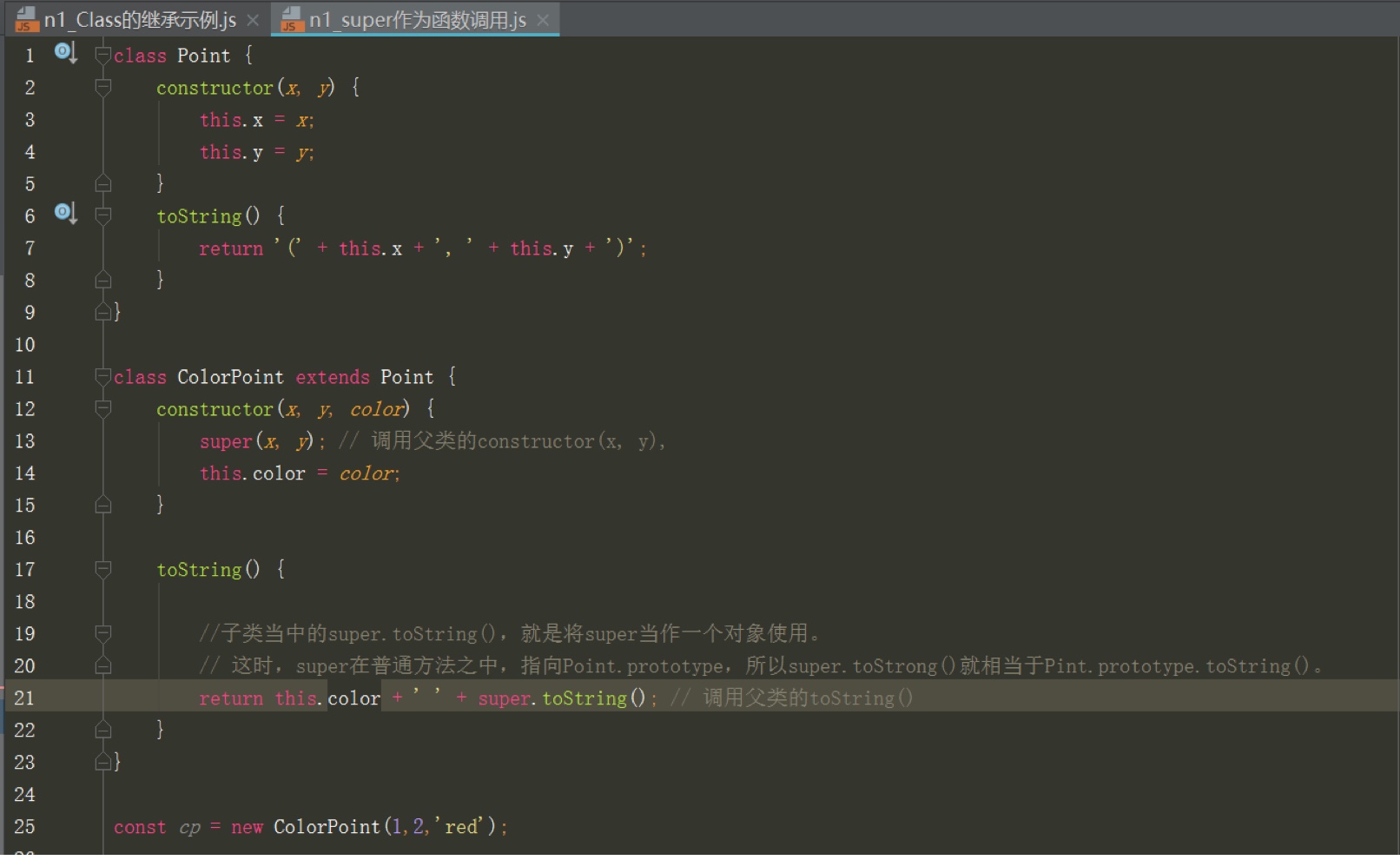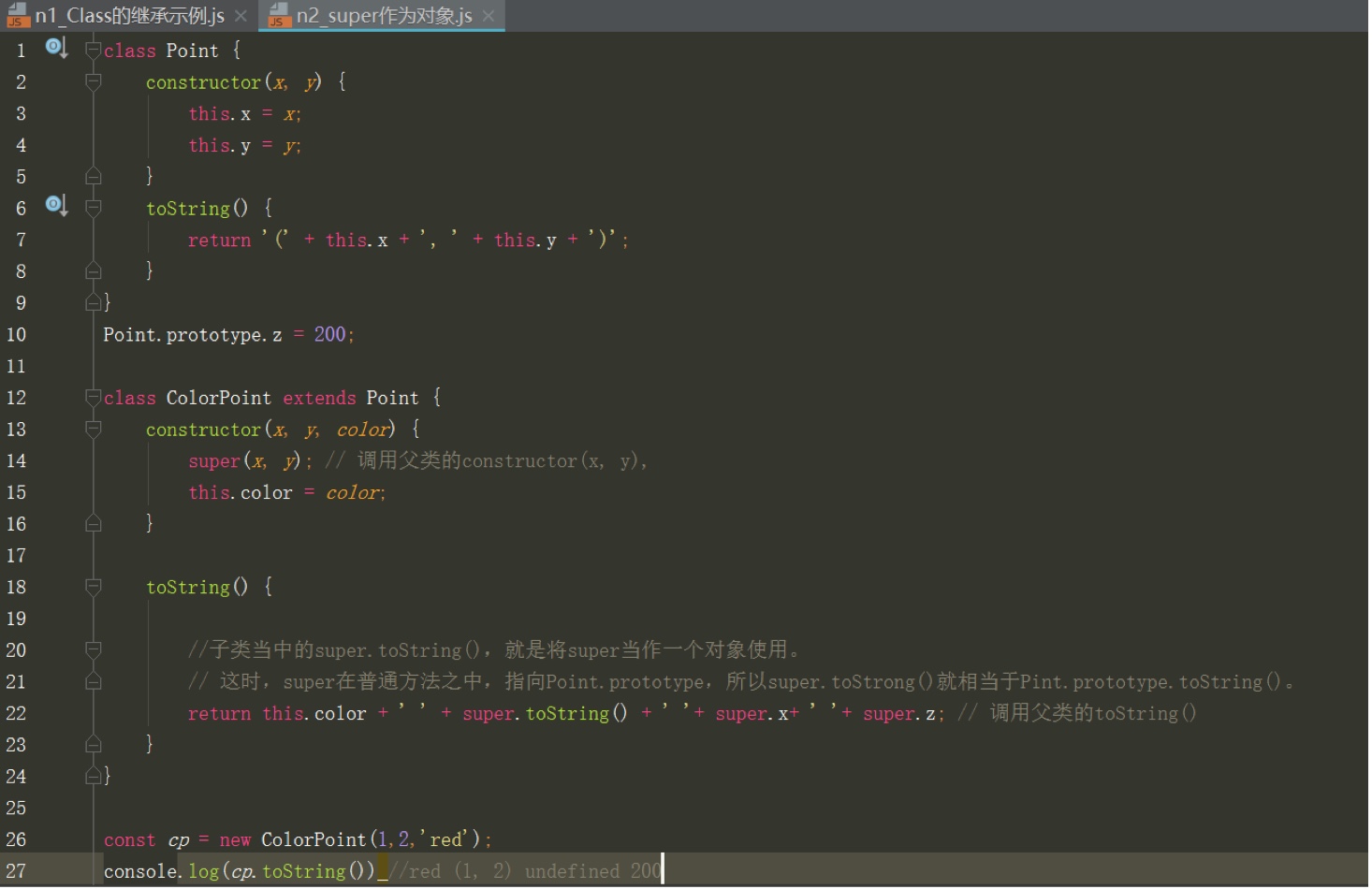ES5-ES6-ES7_class类
传统创建对象模板的方式
JavaScript 语言中,生成实例对象的传统方法是通过构造函数
//JavaScript 语言中,生成实例对象的传统方法是通过构造函数 function Point(x, y) { this.x = x; this.y = y; } Point.prototype.toString = function () { return '(' + this.x + ', ' + this.y + ')'; }; var p = new Point(1, 2); console.log(p.toString()); //(1, 2)
ES6创建对象模板的方式Class
ES6 提供了更接近传统语言的写法,引入了 Class(类)这个概念,作为对象的模板。通过class关键字,可以定义类
基本上,ES6 的class可以看作只是一个语法糖,它的绝大部分功能,ES5 都可以做到,新的class写法只是让对象原型的写法更加清晰、更像面向对象编程的语法而已
ES6 的类,完全可以看作构造函数的另一种写法
//ES6 提供了更接近传统语言的写法,引入了 Class(类)这个概念,作为对象的模板。通过class关键字,可以定义类 class Point { constructor(x, y) { //构造方法,而this关键字则代表实例对象 this.x = x; this.y = y; } //toString方法。注意,定义“类”的方法的时候,前面不需要加上function这个关键字,直接把函数定义放进去了就可以了。 // 另外,方法之间不需要逗号分隔,加了会报错 toString() { return '(' + this.x + ', ' + this.y + ')'; } } const p = new Point(1,2); //类必须使用new调用,否则会报错。这是它跟普通构造函数的一个主要区别,后者不用new也可以执行 console.log(p.toString()); //(1, 2) console.log(typeof Point) //function,类的数据类型就是函数,类本身就指向构造函数 console.log(Point === Point.prototype.constructor) // true
constructor 方法
constructor方法是类的默认方法,通过new命令生成对象实例时,自动调用该方法。一个类必须有constructor方法,如果没有显式定义,一个空的constructor方法会被默认添加。
//定义了一个空的类Point,JavaScript 引擎会自动为它添加一个空的constructor方法 class Point { } // 等同于 class Point { constructor() {} }
class Foo { constructor() { //constructor方法默认返回实例对象(即this),完全可以指定返回另外一个对象 return Object.create(null); //constructor函数返回一个全新的对象,结果导致实例对象不是Foo类的实例 } } console.log(new Foo() instanceof Foo); // false
类的实例对象
根据类创建实例对象——类必须使用new调用,否则会报错。这是它跟普通构造函数的一个主要区别,后者不用new也可以执行
class Point { constructor(x, y) { this.x = x; this.y = y; } toString() { return '(' + this.x + ', ' + this.y + ')'; } } const p = new Point(1,2); //类必须使用new调用,否则会报错。这是它跟普通构造函数的一个主要区别,后者不用new也可以执行 console.log(p.toString()); //(1, 2)
实例对象属性与原型对象属性——实例的属性除非显式定义在其本身(即定义在this对象上),否则都是定义在原型上(即定义在class上)
class Point { constructor(x, y) { this.x = x; this.y = y; } toString() { return '(' + this.x + ', ' + this.y + ')'; } } const p = new Point(1,2); console.log(p.toString()); //(1, 2) //x和y都是实例对象point自身的属性(因为定义在this变量上)不是原型对象的,所以hasOwnProperty方法返回true console.log(Point.hasOwnProperty('x')) // true console.log(Point.hasOwnProperty('y'))// true console.log(Point.__proto__.hasOwnProperty('y'))// false //toString是原型对象的属性(因为定义在Point类上),不是实例对象的,所以hasOwnProperty方法返回false console.log(Point.hasOwnProperty('toString')) // false console.log(Point.__proto__.hasOwnProperty('toString')) // true
通过__proto__属性为‘类’添加方法
class Point { constructor(x, y) { this.x = x; this.y = y; } toString() { return '(' + this.x + ', ' + this.y + ')'; } } var p1 = new Point(2,3); var p2 = new Point(3,2); //p1和p2都是Point的实例,它们的原型都是Point.prototype,所以__proto__属性是相等的 console.log(p1.__proto__ === p2.__proto__) //true //可以通过实例的__proto__属性为“类”添加方法 p1.__proto__.printName = function () { return 'Oops' }; console.log(p1.printName()) // "Oops" console.log(p2.printName()) // "Oops" var p3 = new Point(4,2); console.log(p3.printName()) // "Oops" //p1的原型上添加了一个printName方法,由于p1的原型就是p2的原型,因此p2也可以调用这个方法。 // 而且,此后新建的实例p3也可以调用这个方法。 // 这意味着,使用实例的__proto__属性改写原型,必须相当谨慎,不推荐使用,因为这会改变“类”的原始定义,影响到所有实例
立即执行的类的实例
let person = new class { constructor(name) { this.name = name; } sayName() { console.log(this.name); } }('张三'); person.sayName(); // "张三"
使用表达式的形式定义类
const MyClass = class Me { getClassName() { return Me.name; } }; //使用表达式定义了一个类。需要注意的是,这个类的名字是MyClass而不是Me,Me只在 Class 的内部代码可用,指代当前类 const p = new MyClass(); console.log(p.getClassName()); //Me,Me只在 Class 内部有定义。
变量提升——类不存在变量提升(hoist), ES6 不会把类的声明提升到代码头部。这种规定的原因与下文要提到的继承有关,必须保证子类在父类之后定义
//Foo类使用在前,定义在后,这样会报错, // 因为 ES6 不会把类的声明提升到代码头部。这种规定的原因与下文要提到的继承有关,必须保证子类在父类之后定 new Foo(); // ReferenceError: Foo is not defined class Foo {}
私有方法
私有方法是常见需求,但 ES6 不提供,只能通过变通方法模拟实现
私有方法模拟实现方式一——在命名上加以区别,方法前面的下划线,表示这是一个只限于内部使用的私有方法。但是,这种命名是不保险的,在类的外部,还是可以调用到这个方法
class Widget { foo (baz) { // 公有方法 this._bar(baz); } _bar(baz) { // 私有方法,_bar方法前面的下划线,表示这是一个只限于内部使用的私有方法 return this.snaf = baz; } } const w = new Widget(); console.log(w._bar('fffffff')) //fffffff,这种命名是不保险的,在类的外部,还是可以调用到这个方法
私有方法模拟实现方式二————将私有方法移出模块,因为模块内部的所有方法都是对外可见的
class Widget { foo (baz) { bar.call(this, baz); } } function bar(baz) { return this.snaf = baz; } //foo是公有方法,内部调用了bar.call(this, baz)。这使得bar实际上成为了当前模块的私有方法 const w = new Widget(); console.log(w.foo('fffff'))
静态方法
静态方法在方法名前面添加一个叫static的修饰符来修饰,那么这个方法就是静态方法,可以直接通过类名来调用,不需要通过创建实例对象来调用
class Foo { static classMethod () { return 'hello static' } } console.log(Foo.classMethod())// hello static
如果通过实例对象来调用静态方法会报错
class Foo { static classMethod () { return 'hello static' } } var f = new Foo() console.log(f.classMethod())//报错:f.classMethod is not a function
Class的继承
Class 可以通过extends关键字实现继承,这比 ES5 的通过修改原型链实现继承,要清晰和方便很多。
子类必须在constructor方法中调用super方法,否则新建实例时会报错。这是因为子类没有自己的this对象,而是继承父类的this对象,然后对其进行加工。如果不调用super方法,子类就得不到this对象
ES6 的继承机制实质是先创造父类的实例对象this(所以必须先调用super方法),然后再用子类的构造函数修改this
如果子类没有定义constructor方法,这个方法会被默认添加,也就是说,不管有没有显式定义,任何一个子类都有constructor方法。
另一个需要注意的地方是,在子类的构造函数中,只有调用super之后,才可以使用this关键字,否则会报错。这是因为子类实例的构建,是基于对父类实例加工,只有super方法才能返回父类实例
class Point { constructor(x, y) { this.x = x; this.y = y; } toString() { return '(' + this.x + ', ' + this.y + ')'; } } class ColorPoint extends Point { constructor(x, y, color) { //this.color = color; //在调用super之前,this是不存在的,所以会报错 super(x, y); // 调用父类的constructor(x, y), this.color = color; } toString() { return this.color + ' ' + super.toString(); // 调用父类的toString() } } const cp = new ColorPoint(1,2,'red'); console.log(Object.getPrototypeOf(ColorPoint)); //[Function: Point] console.log(Object.getPrototypeOf(ColorPoint) === Point); //true
通过继承创建的实例对象所属的类的实例——实例对象cp同时是ColorPoint和Point两个类的实例
class Point { constructor(x, y) { this.x = x; this.y = y; } toString() { return '(' + this.x + ', ' + this.y + ')'; } } class ColorPoint extends Point { constructor(x, y, color) { //this.color = color; //在调用super之前,this是不存在的,所以会报错 super(x, y); // 调用父类的constructor(x, y), this.color = color; } toString() { return this.color + ' ' + super.toString(); // 调用父类的toString() } } const cp = new ColorPoint(1,2,'red'); console.log(cp instanceof Point); // true console.log(cp instanceof ColorPoint); // true
Object.getPrototypeOf()——Object.getPrototypeOf方法可以用来从子类上获取父类,可以使用这个方法判断,一个类是否继承了另一个类
class Point { constructor(x, y) { this.x = x; this.y = y; } toString() { return '(' + this.x + ', ' + this.y + ')'; } } class ColorPoint extends Point { constructor(x, y, color) { //this.color = color; //在调用super之前,this是不存在的,所以会报错 super(x, y); // 调用父类的constructor(x, y), this.color = color; } toString() { return this.color + ' ' + super.toString(); // 调用父类的toString() } } const cp = new ColorPoint(1,2,'red'); console.log(Object.getPrototypeOf(ColorPoint)); //[Function: Point] console.log(Object.getPrototypeOf(ColorPoint) === Point); //true
super关键字
super作为函数调用时,代表父类的构造函数。ES6 要求,子类的构造函数必须执行一次super函数
super虽然代表了父类的构造函数,但是返回的是子类的实例,即super内部的this指的是子类,因此super()在这里相当于父类.prototype.constructor.call(this)。
class Point { constructor(x, y) { this.x = x; this.y = y; console.log(new.target.name); } toString() { return '(' + this.x + ', ' + this.y + ')'; } } class ColorPoint extends Point { constructor(x, y, color) { //子类的构造函数之中的super(),代表调用父类的构造函数。这是必须的,否则 JavaScript 引擎会报错 super(x, y); // 调用父类的constructor(x, y), this.color = color; } toString() { //super(); //SyntaxError: 'super' keyword unexpected here
// 作为函数时,super()只能用在子类的构造函数之中,用在其他地方就会报错
return this.color + ' ' + super.toString(); // 调用父类的toString() } } const cp = new ColorPoint(1,2,'red'); //ColorPoint,创建子类对象的时候,this指向的是子类 console.log(cp.toString()) // red (1, 2)
super作为对象时,在普通方法中,指向父类的原型对象;在静态方法中,指向父类

由于super指向父类的原型对象,所以定义在父类实例上的方法或属性,是无法通过super调用的
如果属性定义在父类的原型对象上,super就可以取到

通过super调用父类的方法时,super会绑定子类的this
class Point { constructor() { this.x = 1; } toString() { return '(' + this.x + ')'; } } Point.prototype.z = 200; class ColorPoint extends Point { constructor() { super(); this.x = 3 } toString() { // 调用父类的toString(),通过super调用父类的方法时,super会绑定子类的this return super.toString(); } } const cp = new ColorPoint(); console.log(cp.toString()) //(3)




